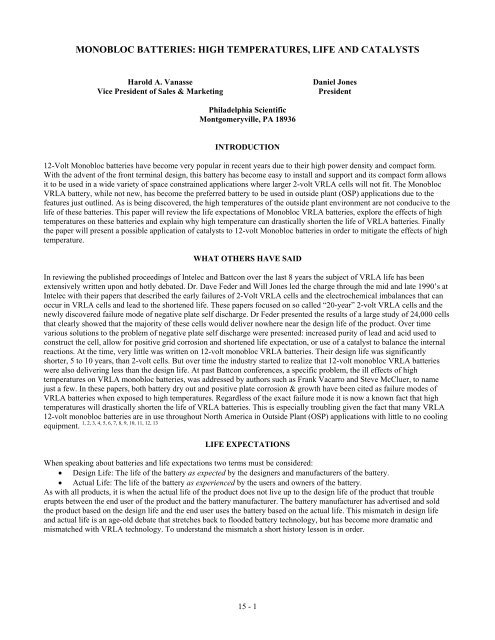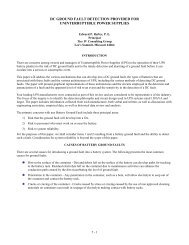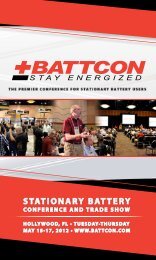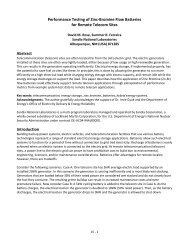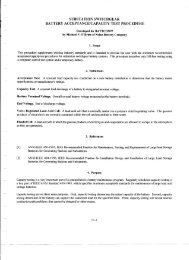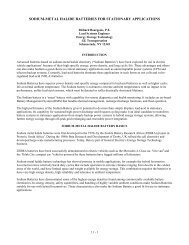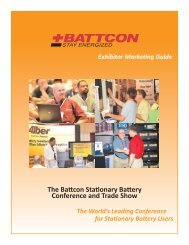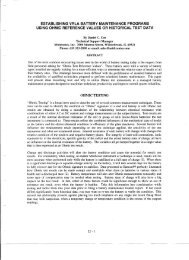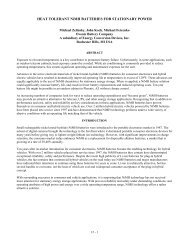Monobloc Batteries: High Temperature, Life and Catalysts - Battcon ...
Monobloc Batteries: High Temperature, Life and Catalysts - Battcon ...
Monobloc Batteries: High Temperature, Life and Catalysts - Battcon ...
Create successful ePaper yourself
Turn your PDF publications into a flip-book with our unique Google optimized e-Paper software.
MONOBLOC BATTERIES: HIGH TEMPERATURES, LIFE AND CATALYSTS<br />
Harold A. Vanasse<br />
Vice President of Sales & Marketing<br />
Daniel Jones<br />
President<br />
Philadelphia Scientific<br />
Montgomeryville, PA 18936<br />
INTRODUCTION<br />
12-Volt <strong>Monobloc</strong> batteries have become very popular in recent years due to their high power density <strong>and</strong> compact form.<br />
With the advent of the front terminal design, this battery has become easy to install <strong>and</strong> support <strong>and</strong> its compact form allows<br />
it to be used in a wide variety of space constrained applications where larger 2-volt VRLA cells will not fit. The <strong>Monobloc</strong><br />
VRLA battery, while not new, has become the preferred battery to be used in outside plant (OSP) applications due to the<br />
features just outlined. As is being discovered, the high temperatures of the outside plant environment are not conducive to the<br />
life of these batteries. This paper will review the life expectations of <strong>Monobloc</strong> VRLA batteries, explore the effects of high<br />
temperatures on these batteries <strong>and</strong> explain why high temperature can drastically shorten the life of VRLA batteries. Finally<br />
the paper will present a possible application of catalysts to 12-volt <strong>Monobloc</strong> batteries in order to mitigate the effects of high<br />
temperature.<br />
WHAT OTHERS HAVE SAID<br />
In reviewing the published proceedings of Intelec <strong>and</strong> <strong>Battcon</strong> over the last 8 years the subject of VRLA life has been<br />
extensively written upon <strong>and</strong> hotly debated. Dr. Dave Feder <strong>and</strong> Will Jones led the charge through the mid <strong>and</strong> late 1990’s at<br />
Intelec with their papers that described the early failures of 2-Volt VRLA cells <strong>and</strong> the electrochemical imbalances that can<br />
occur in VRLA cells <strong>and</strong> lead to the shortened life. These papers focused on so called “20-year” 2-volt VRLA cells <strong>and</strong> the<br />
newly discovered failure mode of negative plate self discharge. Dr Feder presented the results of a large study of 24,000 cells<br />
that clearly showed that the majority of these cells would deliver nowhere near the design life of the product. Over time<br />
various solutions to the problem of negative plate self discharge were presented: increased purity of lead <strong>and</strong> acid used to<br />
construct the cell, allow for positive grid corrosion <strong>and</strong> shortened life expectation, or use of a catalyst to balance the internal<br />
reactions. At the time, very little was written on 12-volt monobloc VRLA batteries. Their design life was significantly<br />
shorter, 5 to 10 years, than 2-volt cells. But over time the industry started to realize that 12-volt monobloc VRLA batteries<br />
were also delivering less than the design life. At past <strong>Battcon</strong> conferences, a specific problem, the ill effects of high<br />
temperatures on VRLA monobloc batteries, was addressed by authors such as Frank Vacarro <strong>and</strong> Steve McCluer, to name<br />
just a few. In these papers, both battery dry out <strong>and</strong> positive plate corrosion & growth have been cited as failure modes of<br />
VRLA batteries when exposed to high temperatures. Regardless of the exact failure mode it is now a known fact that high<br />
temperatures will drastically shorten the life of VRLA batteries. This is especially troubling given the fact that many VRLA<br />
12-volt monobloc batteries are in use throughout North America in Outside Plant (OSP) applications with little to no cooling<br />
1, 2, 3, 4, 5, 6, 7, 8, 9, 10, 11, 12, 13<br />
equipment.<br />
LIFE<br />
EXPECTATIONS<br />
When speaking about batteries <strong>and</strong> life expectations two terms must be considered:<br />
• Design <strong>Life</strong>: The life of the battery as expected by the designers <strong>and</strong> manufacturers of the battery.<br />
• Actual <strong>Life</strong>: The life of the battery as experienced by the users <strong>and</strong> owners of the battery.<br />
As with all products, it is when the actual life of the product does not live up to the design life of the product that trouble<br />
erupts between the end user of the product <strong>and</strong> the battery manufacturer. The battery manufacturer has advertised <strong>and</strong> sold<br />
the product based on the design life <strong>and</strong> the end user uses the battery based on the actual life. This mismatch in design life<br />
<strong>and</strong> actual life is an age-old debate that stretches back to flooded battery technology, but has become more dramatic <strong>and</strong><br />
mismatched with VRLA technology. To underst<strong>and</strong> the mismatch a short history lesson is in order.<br />
15 - 1
For flooded stationary lead acid batteries, the design life of the cell is based on the corrosion of the positive grid material. The<br />
stationary flooded battery design has been refined over many years so that the weakest link is the positive plate. The other<br />
factors that used to cause these batteries to fail have been improved so that the positive plate is the first to go. Much of the<br />
reason that flooded lead acid cells last so long today (generally around 20 years) is that a huge amount of effort went into<br />
selecting <strong>and</strong> designing a positive grid that minimizes corrosion. Pure lead <strong>and</strong> thick grid elements were selected to obtain the<br />
20-year design life. The test methods that were developed to prove out the design <strong>and</strong> to show that corrosion had been<br />
minimized were also used to determine the life expectations of the products themselves. This worked very well in flooded<br />
lead acid cells as history has proven. The life of these batteries could accurately be predicted by the corrosion rate of the<br />
positive grid so battery manufacturers could determine the life without having to wait 20 years. End users could reasonably<br />
expect their flooded stationary lead acid cells to last as long as they were being told because these cells were being used in an<br />
environment that matched the conditions tested for; namely life at room temperature in a controlled central office facility.<br />
<strong>Life</strong> was good.<br />
The problem developed when this life prediction <strong>and</strong> testing was exp<strong>and</strong>ed to VRLA cells. VRLA cells do not behave like<br />
flooded stationary lead acid cells <strong>and</strong> the design has not had as much time to mature. While positive grid corrosion is a big<br />
concern there are other things that must be considered when the electrolyte is minimized. The health of the negative plate<br />
must also be considered, but this was not known at first. In the early days of VRLA technology the same life prediction<br />
equations were used because the thinking at the time was that the limiting life factor would be the positive grid as it was in<br />
flooded stationary lead acid. Time has proven that this is not entirely correct. There is more than one factor at work in VRLA<br />
cells to reduce the life of the battery, especially in high temperature applications. Many of the failure modes that have<br />
impacted VRLA batteries in the past have been greatly reduced by improvements in the design by battery manufacturers.<br />
These include: Post seal leaks, vent design, plate compression, alloy modifications, lead purity, <strong>and</strong> others. The goal of the<br />
industry is to maximize the life span of the positive plate <strong>and</strong> make sure no other cause causes battery failure prior to that<br />
point in time.<br />
Unlike 2-volt VRLA cells, 12-volt monobloc VRLA batteries have shorter life expectations. The design life for 12-volt<br />
monobloc batteries is generally 5 to 10 years depending on the design of the battery <strong>and</strong> the price paid for the product. The<br />
shorter projected life is primarily due to the fact that these batteries have thinner positive plates. The thinner plates allow<br />
these batteries to take up less room <strong>and</strong> cost less for the same capacity as a thicker plate design would. Essentially the user<br />
gets higher energy density <strong>and</strong> higher capacity at a lower cost, but at the expense of a shorter life of the battery. In room<br />
temperature applications, the actual life is acceptable for 12-volt monoblocs. The problem arises when these batteries are<br />
placed in high temperature applications. In these instances there is a large mismatch between the design life <strong>and</strong> the actual<br />
life. In a previous <strong>Battcon</strong> paper it was found that at high temperatures the primary failure mode of 12-volt monobloc VRLA<br />
batteries at 65°C was positive plate corrosion <strong>and</strong> growth <strong>and</strong> that water loss was also seen. 12 Another paper found that the<br />
primary failure mode was dry out. 13 It is clear that sustainability of the 12-volt monobloc VRLA design is at risk in high<br />
temperature applications. The costs of replacing these batteries at remote, outside plant applications every year quickly<br />
surpasses the cost of the battery product itself <strong>and</strong> makes the economic viability of using this product in these high<br />
temperature applications questionable.<br />
TEMPERATURE IMPACT ON LIFE<br />
<strong>Batteries</strong>, unlike other components in the power plant, degrade over time. Unlike mechanical components that wear out, there<br />
is no visible sign of the degradation. Also the process is always progressing <strong>and</strong> can’t be stopped. But there are many factors<br />
that can affect the rate of the degradation. There are design factors such as the purity of the alloys, the thickness of the plates,<br />
etc. There are also environmental or application specific factors that have an impact. The two sets of factors are inter-related,<br />
because the design must be done taking into account the environmental factors that are likely to be encountered. <strong>Temperature</strong><br />
is perhaps the environmental variable that has the biggest impact on the actual life of the battery. This factor has become a<br />
much bigger issue because of the increase in distributed requirements for battery power. There are more applications for<br />
batteries in the outside plant environments where there is no air conditioning. In the past flooded batteries were tested at high<br />
temperatures to accelerate the testing with no expectation that batteries would actually be operated at those temperatures.<br />
Now, the elevated temperatures actually represent the operating environment the battery will see. How long a battery will last<br />
in these high temperature environments is becoming a major concern for end users.<br />
15 - 2
<strong>Temperature</strong> impacts the battery life because higher temperatures cause all chemical reactions to speed up. Battery engineers<br />
are all familiar with the Arrhenius equation that quantifies the impact of a temperature rise on the rate of the chemical<br />
reactions. This equation is based on the concept developed in the late 1800’s by Dr. Svante Arrhenius, a Swedish scientist<br />
who won the Nobel Prize for chemistry in 1903. Generally speaking, for every 10°C rise in temperature the speed of the<br />
reactions double <strong>and</strong> the life is reduced by half. It should be noted that not all chemical reactions will respond to temperature<br />
at the same rate.<br />
When a VRLA battery is exposed to high temperature there is an increase in the current draw of the cell, an increase in water<br />
loss <strong>and</strong> an increase in the rate of corrosion of the positive grid material. <strong>High</strong> temperature causes an increased current draw<br />
because all of the reactions in the cell that govern the charge profile are increased. Increased water loss occurs because it is a<br />
direct result of the increase in current. The scientist Michael Faraday, in the 1830’s, found that water is broken down into its<br />
components of oxygen gas <strong>and</strong> hydrogen gas when an electrical current is passed through it. The rate of decomposition is<br />
directly proportional to the amount of current passed through the water. Since water forms a part of the battery’s electrolyte<br />
the more current that is passed through the battery the more the water portion of the electrolyte will be broken down into<br />
oxygen <strong>and</strong> hydrogen gas. This gas is then free to vent out of the battery <strong>and</strong> lead to the dry out of the battery over time.<br />
Corrosion is increased with temperature on the positive grid because rates of corrosion are directly related to temperature <strong>and</strong><br />
current. 14 The following table summarizes the impact of high temperature on a lead acid battery:<br />
Summary Table: Impact of <strong>High</strong> <strong>Temperature</strong> on <strong>Batteries</strong><br />
Effect of high temperature on battery<br />
Increased current draw<br />
Increased water loss<br />
Increased positive grid corrosion<br />
Reason why<br />
Cell reactions increase with temperature.<br />
Arrhenius Equation<br />
Electrolysis of water is directly related to current.<br />
Faraday’s Law.<br />
Corrosion is directly related to temperature <strong>and</strong><br />
current.<br />
To quantify the impact of temperature on a battery we looked at some of our test data. The following table presents our data<br />
<strong>and</strong> serves as an illustration of a typical rise in float current with temperature that you would find with any VRLA battery.<br />
Table of <strong>Temperature</strong> versus Float Current<br />
<strong>Temperature</strong> Current<br />
(mA/100 Ah)<br />
30°C (86°F) 0.04<br />
40°C (104°F) 0.15<br />
50°C (122°F) 0.25<br />
As the table shows, the current of the cell did increase with increased temperature, which should be no surprise.<br />
While we did not measure the water loss of the cell ourselves there is enough evidence collected <strong>and</strong> written by others to<br />
prove this. One source 15 collected the following data:<br />
Table of Water Loss with <strong>Temperature</strong><br />
<strong>Temperature</strong> Water Loss Per Year<br />
(Grams/100 Ah)<br />
25°C (77°F) 9<br />
35°C (95°F) 18.3<br />
The data shows that the water loss of the cell increases with increasing temperature, which is due to the increased current<br />
draw of the cell; the Arrhenius equation does hold true.<br />
15 - 3
At this point we have shown that high temperature can lead to increased current, increased water loss <strong>and</strong> increased corrosion<br />
of the positive grid in the battery, but what does this mean to the life of the battery. In essence, a higher temperature leads to a<br />
shorter life of the battery, but what can be expected The following table presents the effect of high temperature on battery<br />
life as predicted by applying the Arrhenius equation:<br />
Expected Actual <strong>Life</strong><br />
<strong>Temperature</strong> 5-Year 10-Year<br />
°C °F Design Design<br />
25 77 5 Years 10 Years<br />
35 95 2.5 Years 5 Years<br />
45 113 1.25 Years 2.5 Years<br />
55 131 7.5 Months 1.25 Years<br />
65 149 3.75 Months 7.5 Months<br />
As the table shows the design life is de-rated by half for each 10°C increase in temperature. As an example of how to use the<br />
table, assume that a battery user is getting 2.5 years of actual life from a battery with a design life of 5 years <strong>and</strong> that it is<br />
being run at 35°C. In this case, the battery user is getting exactly what they paid for <strong>and</strong> what the battery was designed for.<br />
The table clearly shows that high temperature can have a dramatic impact on the life of the battery. It is important to note that<br />
the highest temperatures on the table have actually been measured inside the battery compartment of an outside plant cabinet<br />
in the southern US in the summer. 13<br />
ACHIEVING DESIGN LIFE<br />
The design of batteries is a complex matter. For an excellent discussion of the similarities <strong>and</strong> differences between flooded<br />
stationary lead acid <strong>and</strong> VRLA batteries, <strong>and</strong> a bit of history on the trials <strong>and</strong> tribulations involved in the design of both types<br />
of batteries, Dr. Dave Feder’s 2001 Intelec paper is an excellent source. 16 With this background in mind, the question<br />
becomes are there steps that can be taken to ensure that the design life of a lead acid battery is achieved For any lead acid<br />
battery corrosion of the positive grid is the main <strong>and</strong> first concern. Fortunately positive grid corrosion is well understood by<br />
battery engineers <strong>and</strong> has been quantified. The most widely used graph to describe how corrosion affects the positive plate<br />
was developed by J.J. L<strong>and</strong>er. The curve that bears his name shows us that there is a zone where corrosion is minimized in a<br />
lead acid battery <strong>and</strong> also that once out of that zone corrosion of the positive grid is accelerated.<br />
As a general rule for all lead acid batteries, corrosion is a function of the charge voltage (polarization) applied to the positive<br />
plate. In all lead acid batteries there is a fixed amount of charge voltage that is supplied to the battery from the charger. This<br />
charge voltage is distributed to the negative <strong>and</strong> positive plates. The negative plate takes some of the charge voltage <strong>and</strong> the<br />
positive takes the rest. If too much oxygen/hydrogen recombination takes place on the negative plate, this plate becomes<br />
depolarized <strong>and</strong> then the positive plate will end up with all of the charge voltage. This can push the battery into the danger<br />
zone for increased positive grid corrosion (right side of the curve). This can be seen on the L<strong>and</strong>er curve in the Figure 1<br />
below:<br />
15 - 4
Figure 1<br />
It must be noted that much of the information just presented on positive grid corrosion was based on flooded stationary lead<br />
acid cells <strong>and</strong> large 2-volt VRLA cells. Even though 12-volt monobloc VRLA cells employ thin positive plates the rates of<br />
corrosion as developed by L<strong>and</strong>er still apply. The difference between the designs boils down to how much material there is to<br />
work on, which is a question of plate thickness.<br />
CATALYST REFRESHER<br />
In our research on 20-year 2-volt VRLA cells, we have shown that we can shift the polarization into the optimal (minimized)<br />
corrosion zone by using a catalyst mounted inside the gas space of the VRLA cell. We know that this happens by measuring<br />
the float current of the VRLA cell. Generally we see a float current in a catalyst equipped cell that is half of what it is in an<br />
equivalent cell that is not equipped with a catalyst. 10 Since float current <strong>and</strong> positive plate polarization are directly linked <strong>and</strong><br />
directly proportional we know that by reducing the float current we are reducing the positive plate polarization <strong>and</strong> therefore<br />
reducing the rate of corrosion on the positive grid. A catalyst, when placed inside a VRLA cell, provides many benefits to the<br />
cell through its primary role of keeping the negative plate polarized. The benefit of using a catalyst in a VRLA cell has<br />
become accepted as a practical way to ensure the health <strong>and</strong> life of the battery <strong>and</strong> because of this it is now included as an<br />
integral part of the battery by a number of leading battery manufacturers. For further information on this topic please refer to<br />
10, 11<br />
our previous <strong>Battcon</strong> papers.<br />
HIGH<br />
TEMPERATURE TESTING<br />
As we have already said much of the information presented was developed for larger 2-volt cells, but can these results<br />
translate to high temperature applications <strong>and</strong> 12-volt monobloc VRLA battery designs It was thought at one time that the<br />
faster corrosion in the monobloc batteries would absorb enough oxygen to make the catalyst redundant. There has also been<br />
speculation that as temperature rises the subsequent polarization changes in the battery modify the effect of the catalyst. Our<br />
initial experiments do not support either of these theories.<br />
To assess this impact of temperature on catalyst performance in 12-volt monobloc VRLA batteries we conducted a test of<br />
four 12-volt 100 Ah monobloc VRLA batteries. Two of the batteries were equipped with 6 catalysts each (one catalyst per<br />
cell) <strong>and</strong> two of the batteries were not equipped with catalysts – they were considered the control batteries in our test. All<br />
four batteries were float charged at 2.27 volts per cell <strong>and</strong> placed in an oven <strong>and</strong> exposed to temperatures of 30°C, 40°C <strong>and</strong><br />
50°C for periods of 14 days, 14 days <strong>and</strong> 46 days respectively. The following table presents the results of this test:<br />
15 - 5
Table of Test Results: Float Current Measured at <strong>Temperature</strong><br />
<strong>Temperature</strong> Current (mA/100 Ah)<br />
°C °F Catalyst Non-Catalyst Ratio<br />
<strong>Batteries</strong> <strong>Batteries</strong><br />
30 86 0.02 0.04 0.5<br />
40 104 0.08 0.15 0.5<br />
50 122 0.14 0.25 0.6<br />
As can be seen from the test data, we found that at all temperatures the float current of the catalyst equipped batteries was<br />
half of that of the non-catalyst equipped batteries. In other words, the increased temperatures did not have an effect on the<br />
current reducing ability of the catalyst either to increase or decrease its effectiveness. This encouraging result led us to<br />
believe that a catalyst could bring some benefit to a 12-volt monobloc battery. The next step was to quantify that benefit.<br />
The testing that yielded the results above was run for a total of 356 days at 50°C. At the end of the test a capacity test was<br />
conducted on all of the batteries. Figure 2 below shows the results of the capacity test.<br />
Capacity Test Results<br />
100%<br />
90%<br />
80%<br />
70%<br />
60%<br />
50%<br />
40%<br />
30%<br />
20%<br />
10%<br />
0%<br />
Catalyst 1 Catalyst 2 Control 1 Control 2<br />
Figure 2<br />
As can be seen from the graph (Figure 2) the capacity measurements from the two catalyst equipped batteries were very<br />
different from the controls. We then looked through the conductance readings that we had taken on these batteries throughout<br />
the test to see if we could determine or infer at what point in the test that the batteries had failed; we looked for a similar<br />
point of change for both groups. The following table presents the time to failure as inferred from our conductance<br />
measurements.<br />
Time to Battery Failure Based on<br />
Conductance<br />
Catalyst <strong>Batteries</strong> 350 Days<br />
Control <strong>Batteries</strong><br />
250 Days<br />
As can be seen from the table, the catalyst equipped batteries were able to run an extra 100 days before reaching their point of<br />
failure. This is a 40% increase in life. After the capacity test, a tear down <strong>and</strong> inspection of the batteries was performed,<br />
which also yielded differences. The non-catalyst equipped batteries suffered from dry out, positive grid corrosion <strong>and</strong> growth<br />
that lead to internal shorting of the battery <strong>and</strong> had battery jar cracks. The catalyst equipped batteries were still sufficiently<br />
wet (not suffering from dry out) <strong>and</strong> had minimal positive grid corrosion <strong>and</strong> growth. In other words, the catalyst equipped<br />
batteries where in much better physical shape than the non-catalyst batteries. The results of the tear down test were in line<br />
with the capacity <strong>and</strong> life measurements.<br />
15 - 6
As commentary on our test, it must be pointed out that the catalysts used in this test were our 1 amp Microcat® catalyst that<br />
is used in 2-volt VRLA cells. This catalyst design is physically too large to fit into each cell of a monobloc battery in a<br />
production mode. Also, it must be stressed that the results presented are from only one test <strong>and</strong> that they must be repeated on<br />
a large scale with an appropriately sized catalyst.<br />
Our next steps are:<br />
• Develop an appropriately sized catalyst for use in monobloc batteries that will fit in the space constrained<br />
environment.<br />
• Conduct further testing on an exp<strong>and</strong>ed scale to measure the impact of the catalyst on:<br />
o Float current<br />
o Capacity<br />
o <strong>Life</strong><br />
o Positive grid corrosion<br />
o Dry out<br />
• In the course of our testing measure the polarization of the positive <strong>and</strong> negative plates of the batteries to determine<br />
the impact of the catalyst on the batteries reactions at high temperature.<br />
CONCLUSION<br />
12-volt monobloc VRLA batteries are being used in outside plant applications where they are being exposed to high<br />
operating temperatures. This is dramatically shortening the life of these batteries where the cost effectiveness of this battery<br />
type is being called into question. The relatively low cost of the battery is being outweighed by the higher cost of frequent<br />
replacement. The continued pressure to supply batteries to uncontrolled outside plants locations is causing the industry to<br />
look for solutions to the growing problem of shorter than expected battery life. Yes, there is an expectation management issue<br />
because the batteries are being exposed to temperatures beyond the design intent, but at the end of day battery users want cost<br />
effective, energy dense 12-volt monobloc VRLA batteries to deliver a reasonable life.<br />
Our initial testing indicates that the use of a catalyst may allow 12-volt monobloc VRLA batteries to obtain a more<br />
reasonable service life in high temperature environments. More research is required, but the base work that has been<br />
accomplished combines the underst<strong>and</strong>ing of lead acid batteries gained over the last one hundred years with the latest<br />
thinking on ways to improve the technology. If our work is successful <strong>and</strong> a catalyst can allow monobloc batteries to achieve<br />
a longer actual life in high temperature applications, then the economic viability of the product will improve beyond today’s<br />
level. Lead acid battery technology still remains a low cost <strong>and</strong> robust energy storage platform <strong>and</strong> the inclusion of a catalyst<br />
into 12-volt monobloc VRLA batteries may be an important component that allows the battery to achieve its maximum life.<br />
15 - 7
REFERENCES<br />
1. Feder, D.O., “Performance Measurement <strong>and</strong> Reliability of VRLA <strong>Batteries</strong>, Proceedings of INTELEC 1995, P 22.<br />
2. Jones, W.E.M., <strong>and</strong> Feder, D.O., “Float Behavior of VRLA Cells: Theory vs. Reality. Proceedings of INTELEC<br />
1995. p 154.<br />
3. Jones, W.E.M., <strong>and</strong> Feder, D.O., “Behavior of VRLA Cells on Long Term Float.” Proceedings of INTELEC 1996. P<br />
358.<br />
4. Feder, D.O., <strong>and</strong> Jones, W.E.M., “Gas Evolution <strong>and</strong> <strong>Life</strong>time of VRLA Cells – An Attempt to Clarify Fifteen Years<br />
of Confusion & Misunderst<strong>and</strong>ing.” Proceedings of INTELEC 1996.<br />
5. Jones, W.E.M., <strong>and</strong> Feder, D.O., “Correcting Inherent Imbalance <strong>and</strong> Consequent Failure in VRLA Cells by the Use<br />
of <strong>Catalysts</strong>.” Proceeding of Telescon 1997. Section 5.1<br />
6. Cantor, W.P., Davis, E.L., Feder, D.O., & Hlavac, M., “Performance Measurement & Reliability of VRLA <strong>Batteries</strong><br />
– Part II: The Second Generation.” Proceedings of INTELEC 1998. P 369.<br />
7. Berndt, D. <strong>and</strong> Jones, W.E.M., “Balanced Float Charging of VRLA <strong>Batteries</strong> by Means of <strong>Catalysts</strong>.” Proceedings<br />
of INTELEC 1998. P 443.<br />
8. Jones, W.E.M., Vanasse, H.A., et. al., “Can VRLA <strong>Batteries</strong> Last 20 Years” Proceedings of INTELEC 1998. P<br />
461.<br />
9. Jones, W.E.M. “Quantifying Secondary Reactions in VRLA <strong>Batteries</strong>.” Proceedings of INTELEC 2000.<br />
10. Vanasse, H.A. & Jones, D., “Catalyst 101: The Basics of Using <strong>Catalysts</strong> in VRLA Cells.” Proceedings of<br />
BATTCON 2002.<br />
11. Vanasse, H.A. & Jones, D., “Catalyst 201: <strong>Catalysts</strong> & Poisons from the Battery.” Proceedings of BATTCON<br />
2003.<br />
12. Vacarro, F; L<strong>and</strong>ewehrle, R; & Evans, G., “Accelerated <strong>Life</strong> Testing: Does it Satisfy VRLA User <strong>and</strong> Designer<br />
Needs Proceedings of BATTCON 2004. PP 11-1 to 11-8.<br />
13. McCluer,S. Wanted: Real World Battery <strong>Life</strong> Prediction. Proceedings of BATTCON 2003. PP 14-1 to 14-8.<br />
14. Berndt, Dietrich. “Maintenance-Free <strong>Batteries</strong> Based on Aqueous Electrolyte, Lead-Acid, Nickel/Cadmium,<br />
Nickel/Metal Hydride – A H<strong>and</strong>book of Battery Technology, 3 rd Edition.” Research Studies Press, LTD. Baldock,<br />
Hertfordshire, Engl<strong>and</strong>. 2003. P 141.<br />
15. Berndt, Dietrich. “Maintenance-Free <strong>Batteries</strong> Based on Aqueous Electrolyte, Lead-Acid, Nickel/Cadmium,<br />
Nickel/Metal Hydride – A H<strong>and</strong>book of Battery Technology, 3 rd Edition.” Research Studies Press, LTD. Baldock,<br />
Hertfordshire, Engl<strong>and</strong>. 2003. P 159.<br />
16. Feder, D.O., “1950-2001: More Than One-Half Century of Learning How to Live with Each New Generation of<br />
Telecommunication St<strong>and</strong>by <strong>Batteries</strong>.” Proceedings of INTELEC 2001. P47.<br />
BIBLIOGRAPHY<br />
1. Berndt, Dietrich. “Maintenance-Free <strong>Batteries</strong> Based on Aqueous Electrolyte, Lead-Acid, Nickel/Cadmium,<br />
Nickel/Metal Hydride – A H<strong>and</strong>book of Battery Technology, 3 rd Edition.” Research Studies Press, LTD. Baldock,<br />
Hertfordshire, Engl<strong>and</strong>. 2003.<br />
2. Moll, B., Viator, J., Maeda, M., & Manya, S., “Long-Term Study: VRLA Battery <strong>Life</strong> in BellSouth Remote Terminal<br />
Sites.” Proceedings of INTELEC 2004. P 301<br />
3. Muneret, X., “Practical Influence of Float <strong>and</strong> Charge Voltage Adjustment on the Service <strong>Life</strong> of AGM VRLA<br />
<strong>Batteries</strong> Depending on the Conditions of Use.” Proceedings of INTELEC 2004. P 350.<br />
4. Cohen, M., et. al., “<strong>High</strong> Reliability-Low Cost Outdoor Battery Enclosure.” Proceedings of INTELEC 2004. P 429.<br />
5. Calasanzio, D., Caselli, M., <strong>and</strong> McDowall, J., “Underst<strong>and</strong>ing VRLA Charging <strong>and</strong> Other Operational<br />
Characteristics.” Proceedings of INTELEC 1994. P 176.<br />
15 - 8


